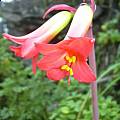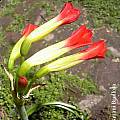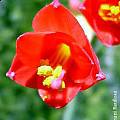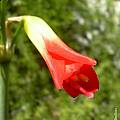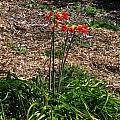Phycella is a genus in the Amaryllidaceae family related to Hippeastrum and Rhodophiala. It is native to the Andes, mostly Chile. The taxonomy of these species is not well determined. The most recent work, not yet published, has found that Phycella is in a clade with Rhodolirion and Placea. This is supported by both chloroplast and nuclear genes. This clade is sister to the rest of the Hippeastreae. This clade has 18 chromosomes and capitate stigmas.
Phycella angustifolia Phil. is the only summer blooming species. It is endemic to Region Metropolitana (where the city of Santiago is located). It has the narrowest leaves.
Phycella australis is very similar to Phycella ignea , but has smaller flowers, is not as tall, and has narrower leaves. A coastal species, it is the southernmost growing species in Chile. Photo by Osmani Baullosa.
Phycella herbertiana Lindl. is a species renamed by Ravenna as Famatina herbertiana. According to Alan Meerow current taxonomic research is finding that Famatina is more closely related to Rhodophiala with both having trifid stigmas and 2n = 16 chromosomes. Therefore photos of this species can be found under Rhodophiala herbertiana which is also a published and accepted name.
Phycella ignea syn. Phycella bicolor is endemic to Chile. Note: Phycella ignea (Lindl.) Lindl. was formerly known as Amaryllis ignea Lindl., Bot. Reg. 10, pl. 809, 1824. That´s why I prefer to call it by this name, instead of Phycella bicolor. Besides, there is another species in Peru, described as Phycella bicolor (R. et P.) Lindl., formerly Amaryllis bicolor R. et P., Fl. Perú et Chil., 3: 57, 1802. Some botanists consider these grow too distantly from one another to be considered the same species.
This species has strap shaped leaves and big tubular bicolor flowers (bright red above and yellow at the base). Although rare in its homeland, it is easily cultivated and makes an excellent bedding plant. It is an autumn and winter grower that flowers in late winter or early spring. Leaves may remain green after blooming time. It goes dormant in early summer. Photos #1-3 were taken by Osmani Baullosa. The last photo was taken by Nhu Nguyen.
Phycella scarlatina Rav. is another species from Chile.
